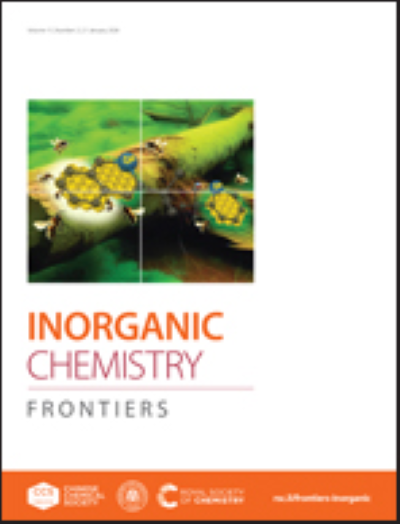Tunable Luminescent Lanthanide Cluster-Based Hydrogel Probe for Ratiometric Detection of Ofloxacin, Anti-Counterfeiting, and Magnetocaloric Applications
IF 6.1
1区 化学
Q1 CHEMISTRY, INORGANIC & NUCLEAR
引用次数: 0
Abstract
Misuse and overuse of antibiotics, especially Ofloxacin (OFX), have become significant global health concerns, emphasizing the urgent need for efficient and accessible detection methods. To address this issue, a series of Ln14 clusters, formulated as [Ln14(acac)24(µ4-OH)2(µ3-OH)16]·C6H14 (LnIII = GdIII (Gd14), TbIII (Tb14), EuIII (Eu14) and SmIII (Sm14)) (Hacac = acetylacetone), were successfully synthesized using the Hacac ligand and lanthanide salts in this work. Among these, Gd14 exhibits typical magnetocaloric effect behavior with the -ΔSmmax of 39.58 J kg-1 K-1 and more importantly, a ratiometric luminescent probe based on Tb9Eu5 by co-doping TbIII and EuIII ions was found enabling visual detection and reusable sensing of OFX in tap water. This marks the first application of lanthanide clusters in ratiometric luminescent detection of OFX. Further to expand the practical applications of this material, a composite film sensor was prepared by incorporating the cluster with carrageenan hydrogel, facilitating visual detection of OFX and anti-counterfeiting. The results demonstrate that the sensor possesses excellent sensitivity for OFX detection and can achieve multi-layered anti-counterfeiting through simple cutting and assembly.基于镧系元素簇的可调谐发光水凝胶探针在氧氟沙星比例检测、防伪和磁热应用中的应用
抗生素,特别是氧氟沙星(OFX)的误用和过度使用已成为重大的全球卫生问题,强调迫切需要有效和可获得的检测方法。为了解决这一问题,本文以Hacac配体和镧系盐为原料,成功合成了一系列Ln14簇,分子式为[Ln14(acac)24(µ4-OH)2(µ3-OH)16]·C6H14 (LnIII = GdIII (Gd14), TbIII (Tb14), EuIII (Eu14)和SmIII (Sm14)) (Hacac =乙酰丙酮)。其中,Gd14表现出典型的磁热效应行为,-ΔSmmax为39.58 J kg-1 K-1,更重要的是,发现了一种基于Tb9Eu5的比例发光探针,通过共掺杂TbIII和EuIII离子,可以实现自来水中OFX的视觉检测和可重复使用传感。这标志着镧系元素簇在比值发光检测OFX中的首次应用。为了进一步扩大该材料的实际应用,将该簇与卡拉胶水凝胶结合,制备了复合薄膜传感器,便于OFX的视觉检测和防伪。结果表明,该传感器具有良好的OFX检测灵敏度,通过简单的切割和组装,可以实现多层防伪。
本文章由计算机程序翻译,如有差异,请以英文原文为准。
求助全文
约1分钟内获得全文
求助全文
来源期刊

Inorganic Chemistry Frontiers
CHEMISTRY, INORGANIC & NUCLEAR-
CiteScore
10.40
自引率
7.10%
发文量
587
审稿时长
1.2 months
期刊介绍:
The international, high quality journal for interdisciplinary research between inorganic chemistry and related subjects
 求助内容:
求助内容: 应助结果提醒方式:
应助结果提醒方式:


